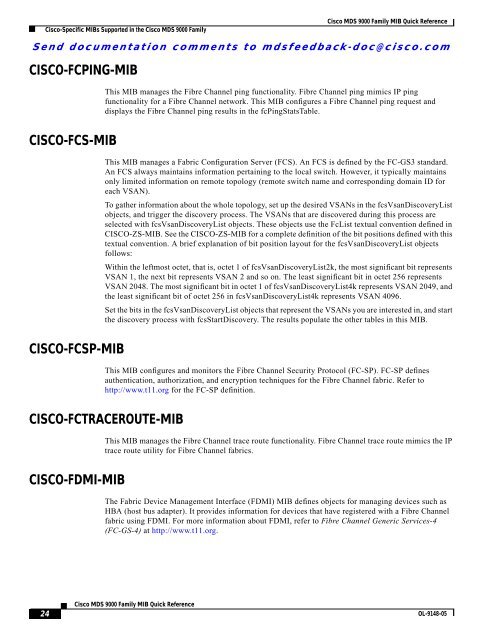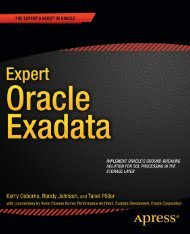Cisco MDS 9000 Family MIB Quick Reference.pdf
Cisco MDS 9000 Family MIB Quick Reference.pdf
Cisco MDS 9000 Family MIB Quick Reference.pdf
Create successful ePaper yourself
Turn your PDF publications into a flip-book with our unique Google optimized e-Paper software.
<strong>Cisco</strong>-Specific <strong>MIB</strong>s Supported in the <strong>Cisco</strong> <strong>MDS</strong> <strong>9000</strong> <strong>Family</strong><br />
<strong>Cisco</strong> <strong>MDS</strong> <strong>9000</strong> <strong>Family</strong> <strong>MIB</strong> <strong>Quick</strong> <strong>Reference</strong><br />
Send documentation comments to mdsfeedback-doc@cisco.com<br />
CISCO-FCPING-<strong>MIB</strong><br />
This <strong>MIB</strong> manages the Fibre Channel ping functionality. Fibre Channel ping mimics IP ping<br />
functionality for a Fibre Channel network. This <strong>MIB</strong> configures a Fibre Channel ping request and<br />
displays the Fibre Channel ping results in the fcPingStatsTable.<br />
CISCO-FCS-<strong>MIB</strong><br />
This <strong>MIB</strong> manages a Fabric Configuration Server (FCS). An FCS is defined by the FC-GS3 standard.<br />
An FCS always maintains information pertaining to the local switch. However, it typically maintains<br />
only limited information on remote topology (remote switch name and corresponding domain ID for<br />
each VSAN).<br />
To gather information about the whole topology, set up the desired VSANs in the fcsVsanDiscoveryList<br />
objects, and trigger the discovery process. The VSANs that are discovered during this process are<br />
selected with fcsVsanDiscoveryList objects. These objects use the FcList textual convention defined in<br />
CISCO-ZS-<strong>MIB</strong>. See the CISCO-ZS-<strong>MIB</strong> for a complete definition of the bit positions defined with this<br />
textual convention. A brief explanation of bit position layout for the fcsVsanDiscoveryList objects<br />
follows:<br />
Within the leftmost octet, that is, octet 1 of fcsVsanDiscoveryList2k, the most significant bit represents<br />
VSAN 1, the next bit represents VSAN 2 and so on. The least significant bit in octet 256 represents<br />
VSAN 2048. The most significant bit in octet 1 of fcsVsanDiscoveryList4k represents VSAN 2049, and<br />
the least significant bit of octet 256 in fcsVsanDiscoveryList4k represents VSAN 4096.<br />
Set the bits in the fcsVsanDiscoveryList objects that represent the VSANs you are interested in, and start<br />
the discovery process with fcsStartDiscovery. The results populate the other tables in this <strong>MIB</strong>.<br />
CISCO-FCSP-<strong>MIB</strong><br />
This <strong>MIB</strong> configures and monitors the Fibre Channel Security Protocol (FC-SP). FC-SP defines<br />
authentication, authorization, and encryption techniques for the Fibre Channel fabric. Refer to<br />
http://www.t11.org for the FC-SP definition.<br />
CISCO-FCTRACEROUTE-<strong>MIB</strong><br />
This <strong>MIB</strong> manages the Fibre Channel trace route functionality. Fibre Channel trace route mimics the IP<br />
trace route utility for Fibre Channel fabrics.<br />
CISCO-FDMI-<strong>MIB</strong><br />
The Fabric Device Management Interface (FDMI) <strong>MIB</strong> defines objects for managing devices such as<br />
HBA (host bus adapter). It provides information for devices that have registered with a Fibre Channel<br />
fabric using FDMI. For more information about FDMI, refer to Fibre Channel Generic Services-4<br />
(FC-GS-4) at http://www.t11.org.<br />
24<br />
<strong>Cisco</strong> <strong>MDS</strong> <strong>9000</strong> <strong>Family</strong> <strong>MIB</strong> <strong>Quick</strong> <strong>Reference</strong><br />
OL-9148-05











